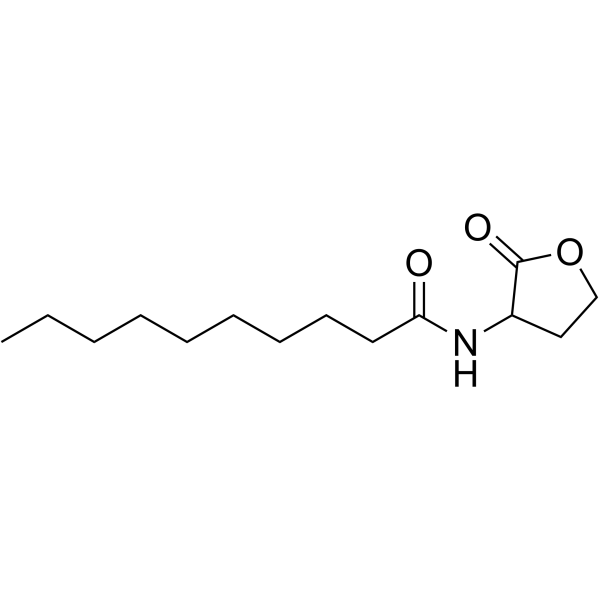N-Decanoyl-Dl-Homoserine Lactone

N-Decanoyl-Dl-Homoserine Lactone structure
|
Common Name | N-Decanoyl-Dl-Homoserine Lactone | ||
|---|---|---|---|---|
| CAS Number | 106983-36-2 | Molecular Weight | 255.35300 | |
| Density | 1.02±0.1 g/cm3 | Boiling Point | 466.1±34.0 °C | |
| Molecular Formula | C14H25NO3 | Melting Point | N/A | |
| MSDS | Chinese USA | Flash Point | N/A | |
|
Nitrite-Oxidizing Bacterium Nitrobacter winogradskyi Produces N-Acyl-Homoserine Lactone Autoinducers.
Appl. Environ. Microbiol. 81 , 5917-26, (2015) Nitrobacter winogradskyi is a chemolithotrophic bacterium that plays a role in the nitrogen cycle by oxidizing nitrite to nitrate. Here, we demonstrate a functional N-acyl-homoserine lactone (acyl-HSL) synthase in this bacterium. The N. winogradskyi genome co... |
|
|
Zoospore interspecific signaling promotes plant infection by Phytophthora.
BMC Microbiol. 10 , 313, (2010) Oomycetes attack a huge variety of economically and ecologically important plants. These pathogens release, detect and respond to signal molecules to coordinate their communal behaviors including the infection process. When signal molecules are present at or ... |
|
|
Quorum sensing and Chromobacterium violaceum: exploitation of violacein production and inhibition for the detection of N-acylhomoserine lactones.
Microbiology 143 , 3703, (1997) Quorum sensing relies upon the interaction of a diffusible signal molecule with a transcriptional activator protein to couple gene expression with cell population density. In Gram-negative bacteria, such signal molecules are usually N-acylhomoserine lactones ... |
|
|
Quorum sensing in the genus Burkholderia.
Int. J. Med. Microbiol. 296 , 103-110, (2006) The genus Burkholderia contains over 30 species, many of which are important human pathogens. In addition to the primary pathogens Burkholderia pseudomallei and Burkholderia mallei, several species have emerged as opportunistic pathogens in persons suffering ... |
|
|
Quorum sensing-dependent regulation and blockade of exoprotease production in Aeromonas hydrophila.
Infect. Immun. 67 , 5192-5199, (1999) In Aeromonas hydrophila, the ahyI gene encodes a protein responsible for the synthesis of the quorum sensing signal N-butanoyl-L-homoserine lactone (C4-HSL). Inactivation of the ahyI gene on the A. hydrophila chromosome abolishes C4-HSL production. The exopro... |
|
|
Detection of acyl-homoserine lactones by Escherichia and Salmonella.
Curr. Opin. Microbiol. 14 , 188-193, (2011) Escherichia and Salmonella do not synthesize quorum-sensing signaling molecules of the N-acyl-l-homoserine lactone (AHL) type but they can detect AHLs produced by other species of bacteria. AHLs are present in the bovine rumen but not in the remainder of the ... |
|
|
N-acyl homoserinelactone-mediated gene regulation in gram-negative bacteria.
Syst. Appl. Microbiol. 22 , 493-506, (1999) The view of bacteria as unicellular organisms has strong roots in the tradition of culturing bacteria in liquid media. However, in nature microbial activity is mainly associated with surfaces where bacteria form highly structured and cooperative consortia whi... |
|
|
The interaction of N-acylhomoserine lactone quorum sensing signaling molecules with biological membranes: implications for inter-kingdom signaling.
PLoS ONE 5 , e13522, (2010) The long chain N-acylhomoserine lactone (AHL) quorum sensing signal molecules released by Pseudomonas aeruginosa have long been known to elicit immunomodulatory effects through a process termed inter-kingdom signaling. However, to date very little is known re... |
|
|
N-Acylhomoserine lactones are potent neutrophil chemoattractants that act via calcium mobilization and actin remodeling.
J. Leukoc. Biol. 91(1) , 15-26, (2012) In gram-negative bacteria, cell-cell communication based on HSL QS molecules is known to coordinate the production of virulence factors and biofilms. These bacterial signals can also modulate human immune cell behavior. Using a Transwell migration assay, we f... |
|
|
N-acylhomoserine lactone regulates violacein production in Chromobacterium violaceum type strain ATCC 12472.
FEMS Microbiol. Lett. 279 , 124-130, (2008) In tests, Chromobacterium violaceum ATCC 12472 produced several N-acyl-L-homoserine lactones (AHLs). Of these, N-(3-hydroxydecanoyl)-L-homoserine lactone was dominant, and controlled violacein production by quorum sensing. Strain VIR07, an AHL-deficient mutan... |